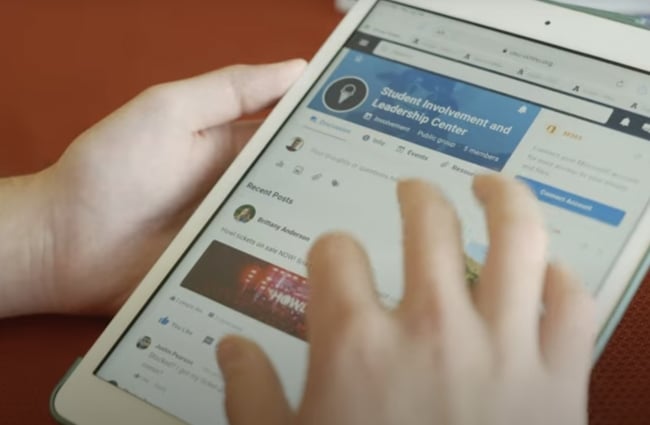You have /5 articles left.
Sign up for a free account or log in.

Six in 10 students in the recent Student Voice survey say they want an events calendar in a campus app. Utah State University’s myUSU platform offers event listings and opportunities for social connection.
Utah State University
In early 2021, amid the social isolation of the pandemic, Utah State University’s student affairs staff was talking internally about updating a decade-old student portal to offer more opportunities for social connection. Around the same time, the university’s then student body president was having parallel conversations on campus about how some kind of digital platform might help Utah State students build community, online and off.
The two parties—student affairs and student government—linked up and drafted something of a mission statement (technically a request for proposals from potential vendors) outlining these and other portal must-haves.
Several months (and a contract with campus portal provider Pathify) later, Utah State launched myUSU 2.0. Many of the portal’s capabilities feel familiar. Students can search for clubs and join as they might do with Facebook groups, for instance. They can view comprehensive and personalized lists of campus events and access student services, the university’s Instagram account and even Canvas, the LMS. Yet myUSU’s one-stop-shop design for all things social and academic sets it apart from many other campus apps and student websites.
“When you go to your myUSU homepage, it is like the Google of Utah State University,” says Carter Ottley, public relations director for the USU Student Association, who is studying journalism and communication.
Ottley’s favorite aspect of myUSU is its calendar feature, which automatically tracks events for all the groups in which he’s enrolled. As someone who’s “very involved” in campus life, he says it’s “nice to have a place that has the event information of all of the organizations I am a part of.”
How Tech Can Promote Involvement
Ottley’s praise for a centralized, customizable calendar makes sense, given that so much is happening during any given week on any given campus, and considering that social media is now so diffuse. That is, students can’t count on all activities being advertised on a single platform.
Ottley’s comment also makes sense in light of the most recent Student Voice survey from Inside Higher Ed and College Pulse, in which many respondents say they’re missing out on opportunities for involvement because they don’t know about them.
Asked how technology could help them feel more connected to campus, for instance, numerous respondents in write-in comments cite the need for a reliable campus events calendar.
Some examples:
“Half the events that go on around campus aren’t advertised very well or I simply lose track of when it is, so having a digital calendar where I can see what events I’m able to attend would be helpful in getting out and about and meeting new people.” —Student at a public university in Idaho
“My biggest gripe is I never seem to know about activities that are planned by different groups. I only happen to see a poster if I’m early to class or someone told me about it. They need to be better advertised!” —Student at a public university in Nevada
What Students Want in a Campus App
For context, the summer Student Voice survey asked 3,000 two- and four-year college students at 170 institutions questions about the college experience outside the classroom, including how technology can promote campus involvement.
What would students like to see in a campus app, whether their institution has one or not? A campus events calendar is the No. 1 choice out of 15 options, with six in 10 students choosing this. Relatedly, the second-most-popular feature is notifications and reminders about campus events, at more than four in 10 students.
Between 30 and 40 percent of students want each of the following in a campus app, though these options are more popular among four-year students (n=2,400) than two-year students (n=600) in the survey: personal schedule management; appointment scheduling for advising, financial aid, mental health care and more; live chat options for student services; notifications about emergency or safety-related situations; connections to free food availability on campus; and dining dollars or a dining points tracker.
Connections to free food availability on campus, for instance, appeals to 35 percent of four-year students versus 21 percent of two-year college students. This capability, which is connected to basic needs issues, is also more popular among students receiving financial aid (n=2,181) than those without financial aid (n=734), at 34 percent versus 23 percent, respectively. It’s also more popular among LGBTQIA+ students (n=2,071) than among straight-identifying students (n=908), at 38 percent versus 30 percent.
Less popular app options over all include a transportation shuttle tracker, health and wellness tracker, mental health crisis assistance, and settings that limit phone usage for studying or other reasons.
How Tech Can Boost Campus Involvement
As for what technology would help increase their participation in campus events, such as talks, sporting events and workshops, half of respondents say the ability to participate virtually. This option is especially popular among older students in the survey, with nearly seven in 10 students aged 30 to 39 (n=98) choosing this, compared to about five in 10 of those aged 19 to 23 (n=1,834).
About four in 10 students over all say the ability to receive notifications about events from a campus app would boost their participation, and this option is slightly more popular among younger students in the survey.
A little over four in 10 students also say credits and incentives, such as getting a LinkedIn badge for attendance, would boost their participation in campus events. This option appears to be most popular among respondents aged 30 to 39, with nearly six in 10 choosing this option. This age group is also the likeliest in the survey to be working full-time, with more than half (52 percent) doing so.
What technological features would help make campus events more enjoyable? Nearly half of students say audience games, though this option is much more popular among four-year students than two-year students (50 percent versus 30 percent, respectively). Four in 10 students say audience polls, and three in 10 say QR codes to interact with.
Such interaction is already in place on some campuses: Alabama A&M University, for instance, uses a platform called Presence to allow students to check in to events to be eligible for drawings and to rate aspects of the experience.
Fewer than a quarter of Student Voice respondents say they’d be interested in virtual reality elements at campus events, and fewer still say they’d enjoy wearable tech and live translation. This is consistent across all major racial groups in the survey, which didn’t filter by disability status.
Jenay Robert, a senior researcher at Educause and co-author of a recent report on the holistic student experience, says that technology’s role in student involvement outside the classroom (not just engagement in the classroom) is a growing area of research interest, “especially as we’re seeing the proliferation of remote modalities and people are realizing that these modalities are not just useful for shifting the modality of your class, but in other ways, as well.”
Robert urges leaders looking at these issues within the contexts of their own institutions to keep in mind that “different students who have different circumstances in their lives have different preferences” for involvement. Students who live on campus have different preferences from those who live off campus, for example, so knowing one’s students and disaggregating relevant data is “really important for thinking about how to engage students with institutional offerings.”
Kathe Pelletier, director of the teaching and learning program at Educause, who co-wrote the recent report, adds that just as educators are broadening their sense of what the engaged student looks like in the classroom, campus leaders need to recognize different kinds of meaningful campus involvement. Ultimately, students need “lots of different opportunities to be engaged in ways that that fit their needs that aren’t just the traditional clubs or sports.”
Both Pelletier and Robert also encourage leaders to rethink any policies that could restrict students’ opportunities for involvement via emerging modalities.
In the Student Voice survey, numerous students also wrote that they wish technology could better promote peer-to-peer connection, in some cases describing a theoretical platform that resembles myUSU, which is available on the web and as an app.
Examples:
“Technology would help me connect to campus more if there were more and better designed outreach systems that weren’t on social media. I don’t use Instagram so I am out of the loop for most events and outreach programs; I would appreciate having a better and more comprehensive college app that includes a full listing of events and club meetings, as well as promoting more connection with the student body.” —Student at a public university in Michigan
“If students are able to connect and have better interactions with people using an official college app, it will not only help the community to grow as a whole but also genuinely find groups of students who are passionate about the same topic quickly without having to physically look for such students and having the possibility of not finding all of them.” —Student at a private college in Illinois
“Technology can play a crucial role in helping students feel more connected to campus by offering various tools and platforms to enhance communication, engagement and accessibility. Campus-specific social media groups and online communities can help students connect with their peers, share experiences, and ask questions. These platforms facilitate real-time communication and help students build a sense of belonging.” —Student at a public college in New York
Utah State doesn’t have precise data on how myUSU 2.0 has increased campus involvement, as that’s a tough thing to measure. But engagement on the platform is strong. Last year there were some 83,000 active users, more than 60 percent of eligible participants (who include recent and not just current students). Each post got an average of 485 views, and 220 groups were formed. Group joins jumped 42 percent. Since August alone, the platform has seen 1.7 million user sessions and 359 events added.




